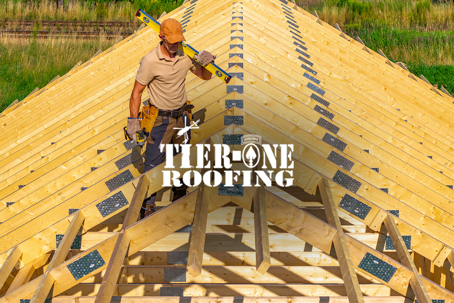Birds, Pests, and Heat: How Summer Wildlife Can Damage Your Roof
When you think about roof damage, you probably picture hail, wind, or falling branches. But one of the most overlooked threats to your roof—especially in summer—is wildlife. Birds nesting in your eaves, squirrels chewing on your shingles, raccoons tearing through soffits, or even wasps building nests in your vents can all compromise your home’s first line of defense.
Add Oklahoma’s intense summer heat into the mix, and you have the perfect storm for hidden roof damage.
At Tier-One Roofing, we’ve seen vacation homes, lake houses, and primary residences alike suffer thousands of dollars in damage from something as small as a persistent woodpecker or a determined squirrel. Here’s what you need to know and how to protect your home.
How Wildlife Targets Roofs in Summer
Summer is peak activity season for animals and insects. Here’s why your roof is so appealing:
Birds: Eaves and vents make perfect nesting spots, but their droppings are highly acidic and can damage roofing materials.
Squirrels: They chew through shingles, fascia boards, and sometimes even wiring in the attic.
Raccoons: Strong and persistent, they can tear open soffits or vents to create a den.
Bats: They often nest in attics through gaps, leaving behind droppings that pose health hazards.
Wasps and Bees: Their nests clog ventilation systems and can damage wood surfaces over time.
Rodents: Mice and rats chew insulation, wiring, and wood framing, increasing fire risk.
These animals aren’t trying to be destructive—they’re just looking for shelter. But their presence can shorten roof life and cause dangerous structural issues.
Signs of Animal or Insect Roof Damage
You don’t need to see an animal on your roof to know there’s a problem. Watch for:
Scratching or scurrying noises in the attic
Bird droppings or feathers near vents or eaves
Chewed wood or insulation
Small holes or gaps in soffits, fascia, or roof decking
Nesting material around gutters or roof valleys
Insects swarming around vents or rooflines
These are all signals that your roof has become a summer wildlife hotel—and that it’s time to take action.
Tier-One Roofing inspections include a full wildlife check so you know where your home is vulnerable.
The Role of Heat in Making Roof Damage Worse
Oklahoma’s summer heat can make animal-related roof problems even worse:
Heat warps wood and shingles, making it easier for animals to tear through weak spots.
Softened sealants and flashing allow pests easier entry points.
High attic temperatures encourage animals to seek cooler nesting areas—often your attic.
Dry conditions push wildlife toward homes for water and shelter.
That means even small vulnerabilities become easy access points for animals.
How Animal Damage Leads to Bigger Problems
A raccoon or squirrel problem isn’t just a nuisance—it can be catastrophic:
Leaks: Openings created by wildlife allow water intrusion during summer storms.
Structural weakening: Chewing and clawing can compromise rafters, decking, and insulation.
Fire hazards: Rodents chewing wires can start attic fires.
Health concerns: Animal waste can carry bacteria and viruses, and insect nests can block ventilation.
By the time you notice visible roof damage, it’s often too late to avoid costly repairs.
That’s why Tier-One Roofing focuses on prevention and early detection as part of every roof assessment.
Preventing Wildlife Damage on Your Roof
Seal Entry Points: Make sure soffits, fascia boards, and vents are secure and intact.
Trim Trees Away from Rooflines: Branches provide a highway for squirrels and raccoons.
Install Screens on Vents: Prevent birds, bats, and insects from entering.
Keep Gutters Clean: Clogged gutters attract birds and insects.
Inspect Regularly: Especially after storms, which can create gaps animals exploit.
Tier-One Roofing offers seasonal maintenance plans that include pest entry point inspections and sealing, keeping wildlife out where they belong.
What to Do If You Already Have Wildlife in Your Roof
Stay Safe: Avoid confronting wildlife yourself—some carry diseases or may attack if cornered.
Call a Professional: Pest control handles removal safely.
Schedule a Roof Inspection: Tier-One Roofing will evaluate the damage, document it for insurance if needed, and make repairs.
Reinforce Vulnerable Areas: Prevent re-entry by strengthening weak points.
The goal is not just to get rid of today’s problem but to keep it from happening again.
How Tier-One Roofing Handles Wildlife Roof Damage
We don’t just patch holes—we look at the bigger picture:
Full attic and roof inspection: We find all entry points, not just the obvious ones.
Photo documentation: You see exactly what we find and what needs fixing.
Permanent solutions: We repair with wildlife resistance in mind, from reinforced fascia to vent guards.
Local expertise: We know which pests are most common in Grand Lake, Tulsa, and across Oklahoma.
Because protecting your home is about more than shingles—it’s about keeping every layer secure.
Keep Your Roof and Home Safe This Summer
Summer wildlife doesn’t have to mean roof damage. With proper inspection, prevention, and fast repairs, your home stays safe and comfortable.
Call Tier-One Roofing today for a free summer roof inspection. We’ll check for animal and insect intrusion, seal entry points, and make sure your roof is ready for the Oklahoma heat—and everything it brings with it.
Because your home should be for you and your family—not the wildlife looking for a summer home.

